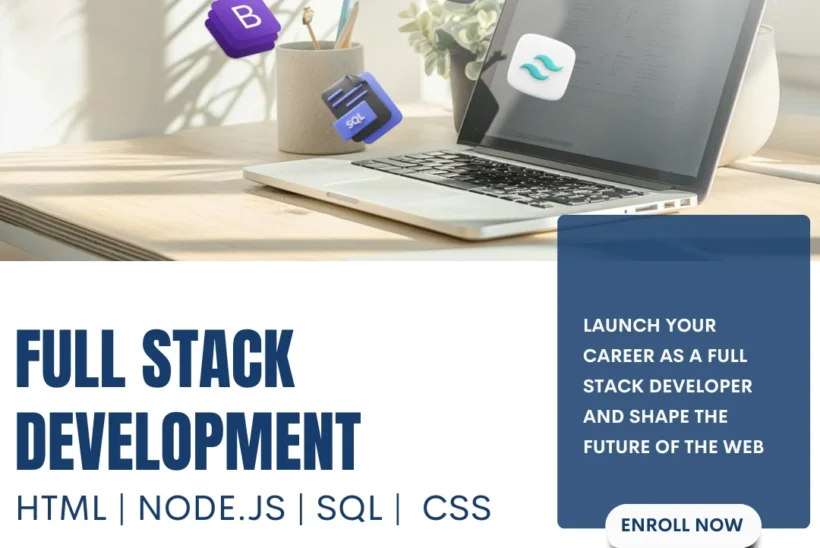Download Course Brochure
Understanding
Full Stack Development is a web development approach that involves working on both the client-side and server-side of a web application. This means that a Full Stack Developer has knowledge of both front-end and back-end technologies. Full Stack Developers can work on the user interface, server-side scripting, database, and everything in between. They are responsible for developing and maintaining web applications from start to finish.
The advantage of Full Stack Development is that it enables developers to work on all aspects of a web application, which results in faster development and better quality. Full Stack Developers have a holistic view of the web application, which enables them to identify and fix issues quickly. It also allows developers to work on multiple projects simultaneously.
Benefits
It offers several benefits over traditional web development approaches. One of the most significant benefits is that it enables developers to work on all aspects of a web application. This means that developers can work on the user interface, server-side scripting, database, and everything in between. Full Stack Developers have a holistic view of the web application, which enables them to identify and fix issues quickly. It also allows developers to work on multiple projects simultaneously.
Another benefit of Full Stack Development is that it results in faster development and better quality. Developers who are Full Stack proficient have the ability to develop and maintain web applications from start to finish, making them better equipped to handle complex projects. This results in faster development times and better quality.
Languages
It involves working with a variety of languages. These languages include HTML, CSS, JavaScript, Python, and Ruby. Web developers use HTML to create the structure of a web page, CSS to style a web page, JavaScript to add interactivity to a web page, Python for back-end development, and Ruby for web development.
Conclusion
Full Stack Development is a comprehensive approach to web development that involves working on the front-end, back-end, and database of a web application. It offers several benefits over traditional web development approaches, including faster development times and better quality. Full Stack Development is becoming increasingly popular, and it is expected to have a significant impact on digital transformation. If you are interested in Full Stack Development, there are several courses and classes available that can help you get started.
Why Choose Us ?
Over 19 Years of Experience
100% Practical Training
Industrial Projects
1 on 1 Mentorship
Rated 4.9 on Google
Resume Feedback
Focus on Practical Skills
100% Placement Assistance
Flexible Timings
Over 19 Years of Experience
100% Practical Training
Industrial Projects
1 on 1 Mentorship
Rated 4.9 on Google
Resume Feedback
Focus on Practical Skills
100% Placement Assistance
Flexible Timings
What Our Students Have To Say About Us
Overall great experience, and recommend for someone starting afresh.
If you're planning to pursue a computer course, I highly recommend visiting Future Vision. All the faculty members are very cooperative, and I want to extend a special thanks to Yash Sir for building my confidence and supporting me throughout the journey.
Thank you, Future Vision, for making this learning experience so enriching.
The institute provided detail learning about graphics. It helped me to sharpen my skills . Highly recommend!
Thanks
Yash sir is very professional, he teaches everything very calmly and class environment was also very good
Future Vision isn’t just a tuition center—it’s a place where students truly understand and enjoy learning about computers and technology. Whether it’s Informatics Practices or other computer-related courses, the teaching here is structured, engaging, and designed to make complex concepts easy to grasp.
What sets Future Vision apart is its focus on practical learning. Instead of just memorizing theory, students get hands-on experience, which builds real skills they can use in the future. The instructors are patient, knowledgeable, and always ready to help, making learning a stress-free and enjoyable process.
Beyond academics, Future Vision creates a positive and motivating environment where students feel encouraged to ask questions, explore new ideas, and build confidence in their abilities. It’s a place that truly prepares students for a tech-driven future, making learning both meaningful and exciting.
Personal attention is been provided by tutors.
It was a good experience learning at future vision.
Great experience
Loved the course and learnt alot
also the explanation was very detailed.
The course material provided was comprehensive and well-organized. The coaching classes provided lecture notes, practice exercises, and additional resources like code samples and reference materials.
The course emphasized practical application through coding exercises and mini-projects.
Considering the quality of teaching, course content, and overall learning experience, I believe the course offered excellent value for money.
Overall, I highly recommend the Python Programming course at the future vision computer institute . It is suitable for beginners and individuals with some prior programming experience looking to expand their knowledge of Python.
My experience was good and I will surely suggest you to take classes from here.
Because Siddharth sir is best sir ever.
He's studing method is so deferent.
Harsh Patel
Mr Yash who explained everything in such a detail that you will learn everything there only. He is really confident in his work and his concepts are crystal clear.
Environment of the place there is very warm.
This place is highly recommended to the ones looking for any computer courses. They have all basic and advanced learning programs.
Have a look at our other courses:
- Advanced Web Designing
- Advanced Graphic Design
- Digital Marketing & SEO
- Advanced Data Analytics
- Business Analytics
What’s App us: +91-8799141678
Contact us at +91 98257 71678
Download Course Brochure
Curriculum
- 16 Sections
- 88 Lessons
- 46 Weeks
- Industrial Live Projects0
- HTML4
- 2.1Basic HTML syntax: You’ll learn about the basic structure of an HTML document, including the DOCTYPE declaration, the , , and elements, and how to create tags.
- 2.2HTML elements: You’ll learn about the different types of HTML elements, including headings, paragraphs, links, images, tables, and forms.
- 2.3HTML attributes: You’ll learn about the different attributes you can use to add information to your HTML elements, such as the “href” attribute for links and the “src” attribute for images.
- 2.4HTML formatting: You’ll learn how to use HTML tags to format your content, such as adding bold or italic text, creating lists, and adjusting the size and color of your text.
- Ajax6
- 3.1Make asynchronous requests to servers: AJAX allows you to make requests to a server in the background without reloading the entire page, which makes web applications faster and more responsive.
- 3.2Retrieve data from servers: With AJAX, you can retrieve data from a server in various formats such as JSON, XML, or HTML, and then use it to dynamically update parts of a web page.
- 3.3Send data to servers: AJAX allows you to send data to a server in various formats, such as JSON or XML, without reloading the entire page.
- 3.4Handle server responses: AJAX provides methods for handling server responses, such as checking the response status, parsing the response data, and updating the page content accordingly
- 3.5Handle errors: AJAX provides methods for handling errors, such as timeouts, network errors, or server errors, and provides mechanisms for displaying error messages to users.
- 3.6Integrate with other web technologies: AJAX can be combined with other web technologies such as jQuery, JavaScript, HTML, and CSS to create dynamic and interactive web applications.
- CSS6
- 4.1CSS syntax: You’ll learn about the basic syntax of CSS, including how to select HTML elements and how to apply styles to them.
- 4.2CSS selectors: You’ll learn about the different types of CSS selectors, including element selectors, class selectors, ID selectors, and attribute selectors.
- 4.3CSS properties: You’ll learn about the different CSS properties you can use to control the appearance of HTML elements, such as font size, color, background color, and margins.
- 4.4CSS box model: You’ll learn about the CSS box model, which describes how the layout of HTML elements is calculated and how padding, borders, and margins affect the size and position of an element.
- 4.5CSS layouts: You’ll learn how to create different types of layouts using CSS, including fixed layouts, fluid layouts, and responsive layouts.
- 4.6CSS frameworks: While not strictly part of CSS, you may also learn about CSS frameworks such as Bootstrap or Foundation, which provide pre-designed CSS styles and layouts that you can use to create websites more easily.
- HTML55
- 5.1Semantic elements: HTML5 introduces new semantic elements that help to structure a web page’s content in a more meaningful way, such as
, - 5.2Multimedia support: HTML5 provides built-in support for multimedia content, including audio and video elements, which makes it easier to embed media files into web pages without relying on third-party plugins.
- 5.3Form controls: HTML5 introduces new form controls that make it easier to create forms with a more user-friendly interface, such as date pickers, color pickers, and range sliders.
- 5.4Geolocation: HTML5 provides support for geolocation, which allows a web page to access a user’s location information if the user grants permission.
- 5.5Web storage: HTML5 introduces web storage APIs, which allow a web page to store data on a user’s local device, making it possible to create web applications that work offline or that can sync data with a server.
- CSS37
- 6.1Selectors: CSS3 introduces new selectors that make it easier to target specific elements, such as the :nth-child() selector, the :not() selector, and the ::selection selector.
- 6.2Box model: CSS3 provides more control over the box model, with new properties such as box-sizing, which lets you control how an element’s width and height are calculated.
- 6.3Transitions and animations: CSS3 introduces new properties and keyframe syntax for creating animations and transitions, which allows you to add more dynamic and interactive effects to web pages.
- 6.4Flexbox and Grid layout: CSS3 provides new layout options with the introduction of the Flexbox and Grid layout modules, which provide powerful tools for creating responsive and flexible layouts.
- 6.5Multiple backgrounds and gradients: CSS3 allows you to use multiple backgrounds and gradients on a single element, making it easier to create complex visual effects.
- 6.6Media queries: CSS3 provides new media queries that allow you to target specific devices or screen sizes, making it easier to create responsive designs that adapt to different devices.
- 6.7Overall, learning CSS3 is essential for anyone who wants to create modern and visually appealing web pages or work in web development.
- Bootstrap5
- 7.1Objected-Oriented PythonCopy
- 7.2Responsive Web Design: Bootstrap is designed to create responsive web pages that automatically adjust to different screen sizes, including desktops, tablets, and mobile devices. You’ll learn how to create layouts that work on all devices.
- 7.3Layouts and Components: Bootstrap provides a wide range of pre-built layouts and components, such as navigation bars, dropdowns, modals, and forms, that you can customize to fit your needs. You’ll learn how to use these components and modify them to create unique designs.
- 7.4Customization: Bootstrap provides extensive customization options, allowing you to modify the default styles and components to match your branding and design requirements.
- 7.5Best Practices: Bootstrap follows industry-standard best practices for web development, including accessibility and mobile-first design. You’ll learn how to create web applications that are optimized for both users and search engines.
- MSQL6
- 8.1SQL (Structured Query Language): SQL is the language used to interact with MySQL and other relational databases. You’ll learn SQL commands and syntax to perform operations such as creating tables, inserting data, updating data, deleting data, and querying data.Copy
- 8.2Database design: You’ll learn about database design principles, including how to create tables and relationships between them, how to choose the appropriate data types for different types of data, and how to optimize database performance.Copy
- 8.3Data manipulation: You’ll learn how to manipulate data stored in a MySQL database, including how to use SQL commands to select, sort, filter, and group data, and how to use functions and operators to perform calculations and transformations on data.Copy
- 8.4Data administration: You’ll learn how to administer a MySQL database, including how to manage users and permissions, how to backup and restore data, and how to optimize database performance.Copy
- 8.5Stored procedures and functions: You’ll learn how to create and use stored procedures and functions, which are pre-written SQL statements that can be stored in the database and executed as needed.Cop
- 8.6Data security: You’ll learn how to secure a MySQL database, including how to prevent unauthorized access to data and how to encrypt sensitive data.Copy
- Jquery6
- 9.1Select and manipulate HTML elements: jQuery makes it easy to select HTML elements on a page using selectors and then manipulate their content, attributes, and styles.Copy
- 9.2Handle events: jQuery provides a unified way of handling events such as clicks, mouse movements, keyboard presses, and form submissions, allowing you to write cleaner and more efficient code.Copy
- 9.3Animate elements: jQuery allows you to animate HTML elements, including their positions, sizes, colors, and opacity. Animations can be triggered by events or run continuously.Copy
- 9.4Manipulate the DOM: jQuery provides powerful methods for manipulating the Document Object Model (DOM), such as adding, removing, and modifying elements and their content.Copy
- 9.5Make AJAX requests: jQuery simplifies the process of making AJAX requests to a server and receiving data in response, allowing you to build more dynamic and responsive web pages.Copy
- 9.6Use plugins: jQuery has a vast library of plugins that can be used to extend its capabilities, such as adding new animation effects or enhancing form validation.Copy
- JSON3
- 10.1Understand the JSON syntax: JSON syntax is based on JavaScript object notation, and it is easy to learn and understand. JSON data is represented as key-value pairs, and the data can be nested.Copy
- 10.2Convert data between different formats: JSON can be converted to and from other data formats such as XML, CSV, and YAML, making it a versatile data interchange format.Copy
- 10.3Integrate with other web technologies: JSON can be integrated with other web technologies such as JavaScript, jQuery, and AJAX to create dynamic and interactive web applications.Copy
- JAVASCRIPT6
- 11.1Basic Syntax And Data Types: Variables, Operators, Strings, Numbers, Booleans, Arrays, Objects, Etc.
- 11.2Control Structures: If/Else Statements, For/While Loops, Switch Statements, Etc.
- 11.3Functions And Scope: Function Definition And Invocation, Closures, Hoisting, Etc.
- 11.4DOM Manipulation: Selecting Elements, Changing Their Attributes And Properties, Handling Events, Etc.
- 11.5Asynchronous Programming: Callbacks, Promises, Async/Await, Etc.
- 11.6Error Handling And Debugging: Handling Exceptions, Debugging Tools, Etc.
- PHP10
- 12.1Taking User Input From Forms Via PHP
- 12.2Variables And Expressions In PHP
- 12.3PHP Operators
- 12.4Conditional Tests And Events In PHP
- 12.5PHP Flow Control
- 12.6Taking User Input From Forms Via PHP
- 12.7Variables And Expressions In PHP
- 12.8PHP Operators
- 12.9Conditional Tests And Events In PHP
- 12.10PHP Flow Control
- MongoDB10
- 13.1How To Install And Set Up A Mongodb Database.
- 13.2How To Use The Mongodb Command-Line Interface To Manage And Query Data.
- 13.3How To Design And Implement Effective Data Models Using Mongodb.
- 13.4How To Create, Read, Update, And Delete (CRUD) Documents In A Mongodb Database.
- 13.5How To Integrate Mongodb With Other Technologies Such As Node.Js, Python, And Java.
- 13.6How To Integrate Mongodb With Other Technologies Such As Node.Js, Python, And Java.
- 13.7How To Optimize Mongodb Performance And Troubleshoot Common Issues.
- 13.8How To Ensure Data Security And Manage User Authentication And Authorization.
- 13.9How To Use Mongodb Atlas, The Fully Managed Cloud Database Service, To Host Your Mongodb Database In The Cloud.
- 13.10How To Work With Mongodb’s Advanced Features Such As Indexing, Sharding, And Replication.
- Node.js10
- 14.1How To Set Up Node.Js On Your Machine And Get Started With Building Applications.
- 14.2How To Use Node.Js To Create Server-Side Web Applications And Apis.
- 14.3How To Work With Node.Js Modules And Packages, Including The Node Package Manager (NPM).
- 14.4How To Use Node.Js With Popular Web Frameworks Such As Express.Js And Hapi.Js.
- 14.5How To Use Node.Js To Interact With Databases Such As Mongodb And Mysql.
- 14.6How To Use Node.Js To Build Real-Time Applications Using Technologies Such As Websockets And Socket.IO.
- 14.7How To Use Node.Js For Asynchronous Programming, Including Working With Callbacks, Promises, And Async/Await.
- 14.8How To Use Node.Js To Build Command-Line Tools And Scripts.
- 14.9How To Use Node.Js For Networking, Including Building TCP And HTTP Servers And Clients.
- 14.10How To Use Node.Js For File And Stream Processing, Including Working With The File System, Streams, And Buffers.
- Timeline landing page with multipurpose form project in HTML & CSS4
- React Js0
Yash Jain

You might be interested in
-
All levels
-
All levels
-
All levels
-
All levels

















